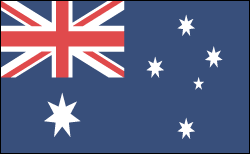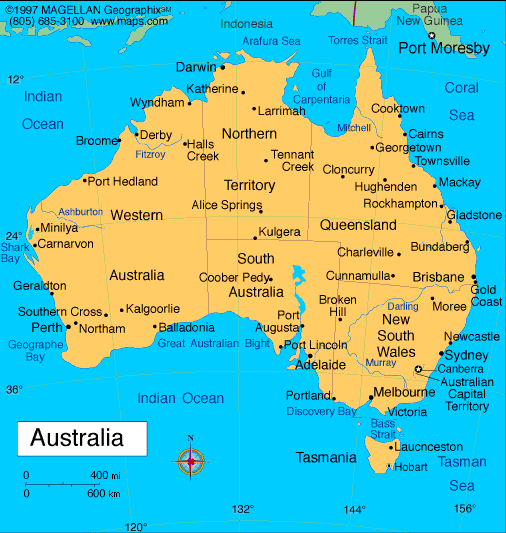AUSTRALIA

Geography: The continent of Australia, with the island state of Tasmania, is approximately equal in area to the United States (excluding Alaska and Hawaii). Mountain ranges run from north to south along the east coast, reaching their highest point in Mount Kosciusko (7,308 ft; 2,228 m). The western half of the continent is occupied by a desert plateau that rises into barren, rolling hills near the west coast. The Great Barrier Reef, extending about 1,245 mi (2,000 km), lies along the northeast coast. The island of Tasmania (26,178 sq mi; 67,800 sq km) is off the southeast coast.
Government: Democracy. Symbolic executive power is vested in the British monarch, who is represented throughout Australia by the governor-general.
History: The first inhabitants of Australia were the Aborigines, who migrated there at least 40,000 years ago from Southeast Asia. There may have been between a half million to a full million Aborigines at the time of European settlement; today about 350,000 live in Australia.
Dutch, Portuguese, and Spanish ships sighted Australia in the 17th century; the Dutch landed at the Gulf of Carpentaria in 1606. In 1616 the territory became known as New Holland. The British arrived in 1688, but it was not until Captain James Cook's voyage in 1770 that Great Britain claimed possession of the vast island, calling it New South Wales. A British penal colony was set up at Port Jackson (what is now Sydney) in 1788, and about 161,000 transported English convicts were settled there until the system was suspended in 1839.
Free settlers and former prisoners established six colonies: New South Wales (1786), Tasmania (then Van Diemen's Land) (1825), Western Australia (1829), South Australia (1834), Victoria (1851), and Queensland (1859). Various gold rushes attracted settlers, as did the mining of other minerals. Sheep farming and grain soon grew into important economic enterprises. The six colonies became states and in 1901 federated into the Commonwealth of Australia with a constitution that incorporated British parliamentary and U.S. federal traditions. Australia became known for its liberal legislation: free compulsory education, protected trade unionism with industrial conciliation and arbitration, the secret ballot, women's suffrage, maternity allowances, and sickness and old-age pensions.
History: The first inhabitants of Australia were the Aborigines, who migrated there at least 40,000 years ago from Southeast Asia. There may have been between a half million to a full million Aborigines at the time of European settlement; today about 350,000 live in Australia.
Dutch, Portuguese, and Spanish ships sighted Australia in the 17th century; the Dutch landed at the Gulf of Carpentaria in 1606. In 1616 the territory became known as New Holland. The British arrived in 1688, but it was not until Captain James Cook's voyage in 1770 that Great Britain claimed possession of the vast island, calling it New South Wales. A British penal colony was set up at Port Jackson (what is now Sydney) in 1788, and about 161,000 transported English convicts were settled there until the system was suspended in 1839.
Free settlers and former prisoners established six colonies: New South Wales (1786), Tasmania (then Van Diemen's Land) (1825), Western Australia (1829), South Australia (1834), Victoria (1851), and Queensland (1859). Various gold rushes attracted settlers, as did the mining of other minerals. Sheep farming and grain soon grew into important economic enterprises. The six colonies became states and in 1901 federated into the Commonwealth of Australia with a constitution that incorporated British parliamentary and U.S. federal traditions. Australia became known for its liberal legislation: free compulsory education, protected trade unionism with industrial conciliation and arbitration, the secret ballot, women's suffrage, maternity allowances, and sickness and old-age pensions.

Map of
Australia
Sovereign: Queen Elizabeth II (1952)
Governor-General: Peter Cosgrove (2014)
Prime Minister: Tony Abbott
(2013)
Land area: 2,941,283 sq mi (7,617,931
sq km); total area: 2,967,893 sq mi (7,686,850 sq km)
Population (2014 est.): 22,507,617 (growth
rate: 1.09%); birth rate: 12.19/1000; infant mortality rate: 4.43/1000;
life expectancy: 82.07
Capital (2011 est.): Canberra, 399,000
Largest cities: Sydney
4.543 million; Melbourne 3.961 million; Brisbane 2.039 million; Perth
1.649 million; Adelaide 1.198 million; CANBERRA (capital) 399,000 (2011)
Monetary unit: Australian
dollar
Languages:
English 76.8%, Mandarin 1.6%, Italian 1.4%, Arabic 1.3%,
Greek 1.2%, Cantonese 1.2%, Vietnamese 1.1%, other 10.4%, unspecified
5% (2011 est.)
Ethnicity/race:
Caucasian 92%, Asian 7%, aboriginal and other
1%
Religions:
Protestant 28.8% (Anglican 17.1%, Uniting Church 5.0%,
Presbyterian and Reformed 2.8%, Baptist, 1.6%, Lutheran 1.2%,
Pentecostal 1.1%), Catholic 25.3%, Eastern Orthodox 2.6%, other
Christian 4.5%, Buddhist 2.5%, Muslim 2.2%, Hindu 1.3%, other 8.4%,
unspecified 2.2%, none 22.3%(2006 est.)
National Holiday:
Australia Day, January 26
Literacy rate: 99% (2011 est.)
Economic summary: GDP/PPP $998.3 billion (2011 est.); per capita $43,000. Real growth rate: 2.5%.
Inflation: 2.4%. Unemployment: 5.7%. Arable land:
6.16%. Agriculture: wheat, barley, sugarcane, fruits;
cattle, sheep, poultry. Labor force: 12.44 million; agriculture
3.6%, industry 21.1%, services 70.4% (2011 est.). Industries:
mining, industrial and transportation equipment, food processing,
chemicals, steel. Natural resources: bauxite, coal, iron ore,
copper, tin, gold, silver, uranium, nickel, tungsten, mineral sands,
lead, zinc, diamonds, natural gas, petroleum. Exports: $251.7 billion (2013 est.): coal, gold, meat, wool, alumina, iron ore, wheat,
machinery and transport equipment. Imports: $245.8 billion (2013 est.): machinery and transport equipment, computers and office
machines, telecommunication equipment and parts; crude oil and
petroleum products. Major trading partners: China, US, Japan, Thailand, Singapore, South Korea, India, Germany (2012).
Member of Commonwealth of Nations
Communications: Telephones: main
lines in use: 10.47 million (2012); mobile cellular: 24.4 million
(2011). Broadcast media: the Australian
Broadcasting Corporation (ABC) runs multiple national and local radio
networks and TV stations, as well as Australia Network, a TV service
that broadcasts throughout the Asia-Pacific region and is the main
public broadcaster; Special Broadcasting Service (SBS), a second large
public broadcaster, operates radio and TV networks broadcasting in
multiple languages; several large national commercial TV networks, a
large number of local commercial TV stations, and hundreds of commercial
radio stations are accessible; cable and satellite systems are
available (2008). Internet
hosts: 17.081 million (2012). Internet users: 15.81 million (2011).
Transportation: Railways:
total: 38,445 km. Highways: total: 823,217 km (2011). Waterways: 2,000 km
(mainly used for recreation on Murray and Murray-Darling river
systems) (2006). Ports and terminals: Brisbane,
Cairns, Dampier, Darwin, Fremantle, Gladstone, Geelong, Hay Point,
Hobart, Jervis Bay, Melbourne, Newcastle, Port Adelaide, Port
Dalrymple, Port Hedland, Port Kembla, Port Lincoln, Port Walcott,
Sydney. Airports: 480 (2013).
International disputes: In
2007, Australia and Timor-Leste signed agreed to a 50-year development
zone and revenue sharing arrangement and deferred a maritime boundary;
Australia asserts land and maritime claims to Antarctica; Australia's
2004 submission to Commission on the Limits of the Continental Shelf
(CLCS) extends its continental margins over 3.37 million square
kilometers, expanding its seabed roughly 30 percent beyond its claimed
exclusive economic zone; all borders between Indonesia and Australia
have been agreed upon bilaterally, but a 1997 treaty that would settle
the last of their maritime and Exclusive Economic Zone (EEZ) boundary
has yet to be ratified by Indonesia's legislature; Indonesian groups
challenge Australia's claim to Ashmore Reef; Australia has closed parts
of the Ashmore and Cartier reserve to Indonesian traditional fishing.
-------------------- o --------------------
No comments:
Post a Comment